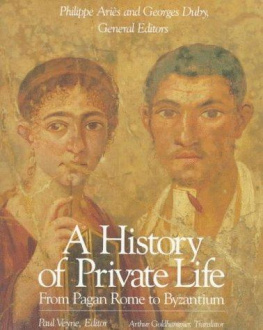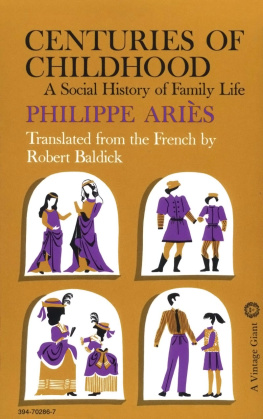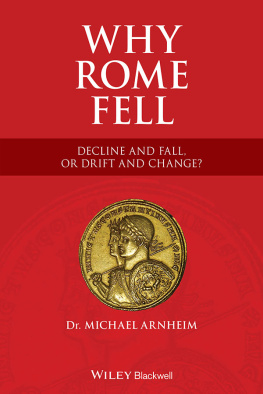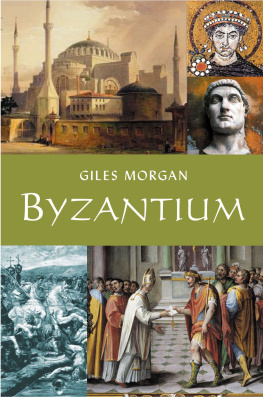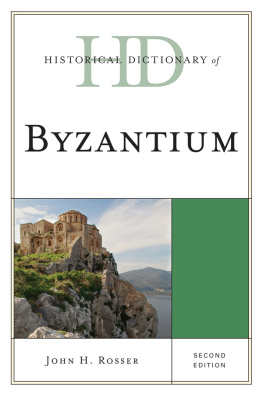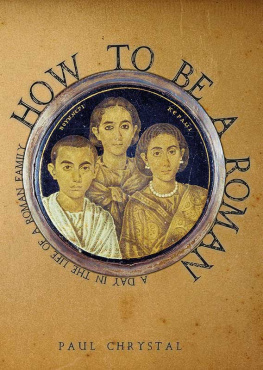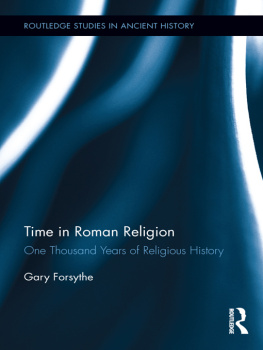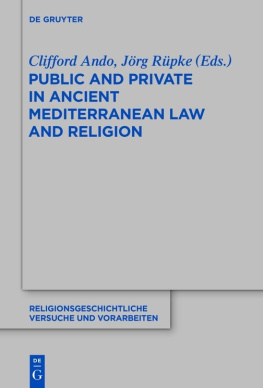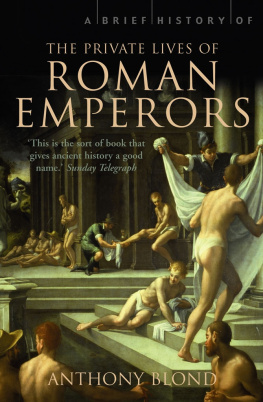Philippe Aries and Georges Duby, General Edi s (c -\ 1 :& \: ^ ~\ 0 ro Paw/V, n a a R me By ', Edi 'rtfciirCk) ium Translator
A HISTORY OF PRIVATE LIFE Philippe Aries and Georges Duby General Editors I From Pagan Rome to Byzantium
A HISTORY OF PRIVATE LIFE I From Pagan Rome to Byzantium Paul Veyne, Editor Arthur Goldhammer, Translator The Belknap Press of Harvard University Press CAMBRIDGE, MASSACHUSETTS AND LONDON, ENGLAND
Copyright 1987 by the President and Fellows of Harvard College All rights reserved Printed in the United States of America Originally published as Histoire de la vie Privee, vol. 1, De I 'Empire romain a Van mil, Editions du Seuil, 1985. BOMC offers recordings and compact discs, cassettes and records. For information and catalog write to BOMR, Camp Hill, PA 17012. Library of Congress Cataloging-in-Publication Data Histoire de la vie privee. English. A history of private life. Translation of: Histoire de la vie privee. Bibliography: p. Includes index. Contents: v. 1. From pagan Rome to Byzantium / Paul Veyne, editor. 1. Manners and customsCollected works. 2. Family HistoryCollected works. 3. CivilizationHistory Collected works. 4. EuropeSocial conditions Collected works. I. Aries, Philippe, II. Duby, Georges. III. Title. GT2400.H5713 1987 390'.009 86-18286
Contents Foreword by Georges Duby Introduction by Paul Veyne The Roman Empire by Paul Veyne Introduction From Mother's Womb to Last Will and Testament Marriage Slavery The Household and Its Freed Slaves Where Public Life Was Private "Work" and Leisure Patrimony Public Opinion and Utopia Pleasures and Excesses Tranquilizers Late Antiquity by Peter Brown Introduction The "Wellborn" Few Person and Group in Judaism and Early Christianity Church and Leadership The Challenge of the Desert East and West: The New Marital Morality Private Life and Domestic Architecture in Roman Africa by Yvon Thebert The Roman Home: Foreword by Paul Veyne Some Theoretical Considerations The Domestic Architecture of the Ruling Class "Private" and "Public" Spaces: The Components of the Domus How the Domus Worked Conclusion vii I 5 6 9 33 5i 7i 95 117 139 161 183 207 235 237 239 253 269 287 297 313 315 319 325 353 383 407
The Early Middle Ages in the West by Michel Rouche 411 Introduction by Paul Veyne 413 Historical Introduction 415 Private Life Conquers State and Society 419 Body and Heart 453 Violence and Death 485 Sacred and Secret 519 Conclusion 548 Byzantium in the Tenth and Eleventh Centuries by Evelyne Patlagean 551 The Byzantine Empire 553 Private Space 567 Self and Others 591 The Inner Life 617 Private Belief 633 Conclusion 641 Notes 645 Bibliography 647 Acknowledgments 659 Index 661
Foreword to A History of Private Life Georges Duby I HE IDEA of preparing a history of private life for a broad audience JL came originally from Michel Winock. Philippe Aries took it up, and it was he who initiated this undertaking. The work that we have done, with him for a number of years and then, sadly mourning his premature death, without him, is dedicated to the memory of this generous historian, who pursued his fresh and penetrating insights wherever they carried him. The boldness of his work is well-known: he was the first to illuminate what had seemed impenetrable reaches of modern history, opening new pathways for research and inviting other pioneers to follow him in the investigation of childhood, family life, and death, in seventeenth- and eighteenth-century Europe. That we have been able to finish this work at all we owe to Aries's enthusiasm and to his boldness, wonderfully unfettered by academic routine. Without these qualities of his we might have lost heart, but guided by his judicious counsel, freely offered at planning meetings, at our medievalists' colloquium at Senanque in September 1981, and at the final stop on his scientific itinerary, a colloquium that he himself chaired in Berlin, we were able to carry on. Our project was fraught with peril. The ground we hoped to explore was untouched. No one had sifted through or even identified useful source materials, which at first glance seemed abundant but scattered. We had to clear away the brush, stake our claim, and, like archaeologists approaching a site known to contain riches too great to be systematically explored, settle for excavating a few preliminary trenches. We took our bearings without deluding ourselves into thinking that the time was ripe for a synthetic overview. Obliged to feel our way as we went, we decided from the outset that we would present our readers with a program of research rather than a finished summary. The five parts of this book ask many more questions than they answer. We hope that they will arouse curiosity and encourage other researchers to continue our work, to explore new ground, and to dig deep where we have only scratched the surface.
viii Foreword to a History of Private Life We faced another, less obvious but more troublesome problem. We had decided that our research should cover all of Western history and that it should emphasize the longue duree. To a period of more than two millennia and to all of Europe, with its diversity of regional ways and customs, we would therefore be applying a conceptthat of personal lifethat had come into common use in certain parts of Europe only quite recently, in the nineteenth century. How should we go about writing the prehistory of such a concept? How should we define the realities that it subsumed over the ages? We needed to circumscribe the topic precisely in order to avoid wandering off into yet another investigation of "daily life." When it came to discussing the history of residential dwellings, for example, we hoped to avoid using bedrooms and beds as a springboard for speculation about the history of individualism, or worse, of intimacy. We started from the obvious fact that at all times and in all places a clear, commonsensical distinction has been made between the public that which is open to the community and subject to the authority of its magistratesand the private. In other words, a clearly defined realm is set aside for that part of existence for which every language has a word equivalent to "private," a zone of immunity to which we may fall back or retreat, a place where we may set aside arms and armor needed in the public place, relax, take our ease, and lie about unshielded by the ostentatious carapace worn for protection in the outside world. This is the place where the family thrives, the realm of domesticity; it is also a realm of secrecy. The private realm contains our most precious possessions, which belong only to ourselves, which concern nobody else, and which may not be divulged or shown because they are so at odds with those appearances that honor demands be kept up in public. An indoor business, a matter of events that take place behind closed doors and under lock and key, private life might seem to be walled off from prying eyes. But, on either side of that "wall," whose integrity the bourgeois of the nineteenth century so vigorously defended, battles constantly rage. Private individuals must use what power they have to fend off the encroachment of the public authorities on their domain. And inside that domain the desire for independence must be contained within bounds, for every private dwelling shelters a group, a complex social organism, within which inequalities and contradictions present in the larger society are brought to a head. Here the clash between male and female power is fiercer than it is outside, the old and the young are locked in struggle, and overbearing masters must cope with impudent servants. Since the Middle Ages, the tendency of our cultural development has been to sharpen this conflict. As the state grew stronger, its intrusions became more aggressive and invasive, while the launching of new
Foreword to a History of Private Life economic initiatives, the declining importance of collective rituals, and the internalization of religious attitudes tended to promote and liberate the individual and increase the importance of other social centers outside the family and the home, making private life more diverse. Starting in cities and towns, the private realm came more and more to be divided into three distinct parts: the home, to which feminine existence remained confined; private places of business, such as the workshop, the commercial shop, the office, and the factory; and places for private gathering and relaxation, such as the cafe or club. The aim of the volumes in this series is to make visible the changes, some rapid, others quite slow, that affected the nature and the idea of private life. For the very quality of private life was subject to constant transformation. At each stage, "some of its features originated in the very distant past," as Philippe Aries noted in one of the working documents he left us. Other features, "of more recent origin, are destined to evolve, either by undergoing further development or by having their evolution cut short or by changing to the point of becoming unrecognizable." Once made aware of the inextricable connections between continuity and innovation, the reader may feel less disoriented by ongoing changes, whose accelerating pace may at times seem troubling. Space for private sociability outside the home and the workplace, for example, may be disappearing. And the distinction between masculine and feminine, which history shows to have been strongly rooted in the distinction between the outside and the inside, the public and the private, is rapidly becoming a thing of the past. There is, I think, an urgent need to protect the essence of individuality from headlong technological progress. For unless we are careful, individual men and women may soon be reduced to little more than numbers in some immense and terrifying data bank.
Next page
